GR5,TC4钛合金十大性能
tc4钛合金

TC4钛合金在组织工程中的应用
应用部位
• 骨组织工程:作为骨组织支架材料,具有良好的生物相 容性、力学性能和耐腐蚀性能 • 软组织工程:作为软组织支架材料,具有良好的生物相 容性、力学性能和降解性能
应用要求
• 制造过程中的质量控制:保证组织工程材料的性能和稳 定性 • 制造过程中的工艺优化:提高组织工程材料的制造效率 和降低成本
制造工艺
• 精密铸造:制造形状复杂的航空航天部件 • 精密锻造:提高合金的力学性能和加工性能 • 精密加工:进行车削、铣削、钻削等精密加工,制造出 高质量的航空航天部件
制造过程中的关键技术
• 控制合金的成分和组织结构:保证航空航天部件的性能 和稳定性 • 控制制造过程中的缺陷:避免产生气孔、裂纹等缺陷
TC4钛合金研究与应用
DOCS SMART CREATE
CREATE TOGETHER
DOCS
01
TC4钛合金的基本特性及成分
TC4钛合金的化学成分及其与其 他钛合金的区别
01
TC4钛合金的化学成分
• 钛(Ti):余量 • 铝(Al):6.0~6.8% • 钒(V):3.5~4.2% • 铁(Fe):2.5~2.9% • 锆(Zr):1.5~2.0% • 镍(Ni):1.0~1.3%
• 采用真空铸造法:避免合金在铸造过程中产生气泡、夹杂物等缺陷 • 控制铸造温度:1600~1700℃ • 铸造过程中的冷却:采用缓慢冷却或分级冷却工艺,避免产生过大的热应力
TC4钛合金的变形加工与热处理工艺
变形加工
• 可采用热成型、冷成型等方法进行加工 • 控制变形温度和速度:避免产生过大的热应力 • 变形过程中的热处理:进行退火、正火等热处理,改善合金的力学性能和加工性 能
TC4钛合金

TC4钛合⾦船、汽车,医药等部门都得到成功的应⽤。
●TC4钛合⾦⼒学性能:抗拉强度σb/MPa≥895,规定残余伸长应⼒σr0.2/MPa≥825,伸长率δ5(%)≥10,断⾯收缩率ψ(%)≥25●TC4钛合⾦密度:4.5(g/cm3)⼯作温度-100~550(℃)●TC4钛合⾦化学成分:TC4含钛(Ti) 余量,铁(Fe)≤0.30,碳(C)≤0.10,氮(N)≤0.05,氢(H)≤0.015,氧(O)≤0.20,铝(Al)5.5~6.8,钒(V)3.5~4.5钛合⾦TC4⾼速铣削表⾯完整性的研究发表于: 2008-3-14 0:01:13来源:深圳宝玛作者:数控机床点击:载⼊中...次由于钛合⾦具有⽐强度⾼、热强度好、耐腐蚀、资源丰富等⼀系列优点,因此在航空、航天等⼯业部门中的应⽤越来越⼴泛,⽤于制作飞机和发动机中的主要构件。
在发动机⽅⾯,⽤于制造压⽓机盘、压⽓机叶⽚、机匣和燃烧室外壳等重要零件;在飞⾏器结构中⽤于制造翼梁、隔框和接头等重要构件。
特别在钛合⾦整体框架和⼤型整体壁板制造过程中,加⼯量相当⼤,⽽且许多薄壁部位必须克服结构上的加⼯变形,亟需解决钛合⾦整体框架和⼤型整体壁板的加⼯效率和加⼯质量问题。
实践证明,⾼速铣切是⽬前能够⾼效可靠地解决这⼀问题的最经济的加⼯⼿段。
因此,有必要研究与钛合⾦⾼速铣削表⾯完整性相关的基础理论。
1 材料特性钛合⾦TC4材料的组成为Ti-6Al-4V,属于(a+b)型钛合⾦,具有良好的综合⼒学机械性能。
⽐强度⼤。
TC4的强度sb=1,012MPa,密度g=4.4×103,⽐强度sb/g=23.5,⽽合⾦钢的⽐强度sb/g⼩于18。
钛合⾦热导率低。
钛合⾦的热导率为铁的1/5、铝的1/10,TC4的热导率l=7.955W/m·K。
钛合⾦的弹性模量较低。
TC4的弹性模量E=110GPa,约为钢的1/2,故钛合⾦加⼯时容易产⽣变形。
2 ⾼速铣削的表⾯完整性试验条件试件尺⼨:420×200×24mm。
钛合金的十大性能
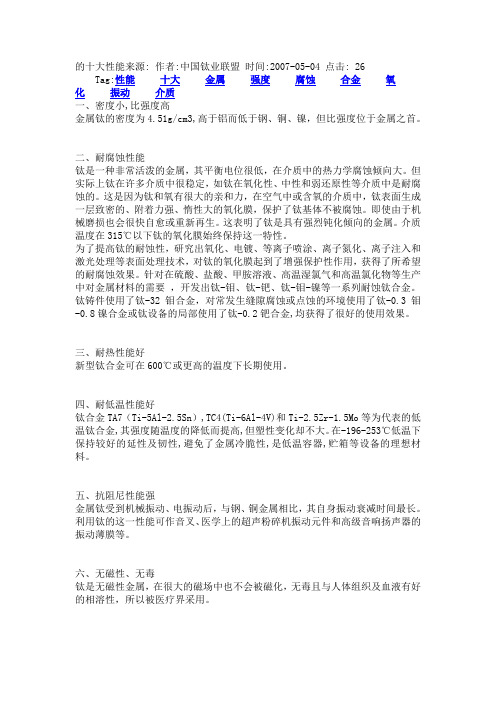
的十大性能来源: 作者:中国钛业联盟时间:2007-05-04 点击: 26 Tag:性能十大金属强度腐蚀合金氧化振动介质一、密度小,比强度高金属钛的密度为4.51g/cm3,高于铝而低于钢、铜、镍,但比强度位于金属之首。
二、耐腐蚀性能钛是一种非常活泼的金属,其平衡电位很低,在介质中的热力学腐蚀倾向大。
但实际上钛在许多介质中很稳定,如钛在氧化性、中性和弱还原性等介质中是耐腐蚀的。
这是因为钛和氧有很大的亲和力,在空气中或含氧的介质中,钛表面生成一层致密的、附着力强、惰性大的氧化膜,保护了钛基体不被腐蚀。
即使由于机械磨损也会很快自愈或重新再生。
这表明了钛是具有强烈钝化倾向的金属。
介质温度在315℃以下钛的氧化膜始终保持这一特性。
为了提高钛的耐蚀性,研究出氧化、电镀、等离子喷涂、离子氮化、离子注入和激光处理等表面处理技术,对钛的氧化膜起到了增强保护性作用,获得了所希望的耐腐蚀效果。
针对在硫酸、盐酸、甲胺溶液、高温湿氯气和高温氯化物等生产中对金属材料的需要,开发出钛-钼、钛-钯、钛-钼-镍等一系列耐蚀钛合金。
钛铸件使用了钛-32钼合金,对常发生缝隙腐蚀或点蚀的环境使用了钛-0.3钼-0.8镍合金或钛设备的局部使用了钛-0.2钯合金,均获得了很好的使用效果。
三、耐热性能好新型钛合金可在600℃或更高的温度下长期使用。
四、耐低温性能好钛合金TA7(Ti-5Al-2.5Sn),TC4(Ti-6Al-4V)和Ti-2.5Zr-1.5Mo等为代表的低温钛合金,其强度随温度的降低而提高,但塑性变化却不大。
在-196-253℃低温下保持较好的延性及韧性,避免了金属冷脆性,是低温容器,贮箱等设备的理想材料。
五、抗阻尼性能强金属钛受到机械振动、电振动后,与钢、铜金属相比,其自身振动衰减时间最长。
利用钛的这一性能可作音叉、医学上的超声粉碎机振动元件和高级音响扬声器的振动薄膜等。
六、无磁性、无毒钛是无磁性金属,在很大的磁场中也不会被磁化,无毒且与人体组织及血液有好的相溶性,所以被医疗界采用。
钛合金常用规格及性能用途

钛合金常用规格及性能用途内部编号:(YUUT-TBBY-MMUT-URRUY-UOOY-DBUYI-0128)钛合金常用规格及性能用途TC4 / GR5 / Ti6AL4V 钛棒现货规格:?直径2mm ?8mm?9mm?10mm ?直径12mm 15mm 16mm 18mm 20mm?25mm?30mm?35mm?40mm?45mm?50mm?55mm?直径60mm 65mm 70mm 75mm 80mm?85mm?90mm?100mm?105mm?110mm?120mm ?TC4 / GR5 / Ti6AL4V 钛棒现货规格:?厚度1mm 2mm 3mm 4mm 5mm 6mm 7mm 8mm 10mm?12mm 14mm ?厚度16mm?18mm 20mm?25mm 30mm 32mm 35mm 50mm 45mm?50mm 60mm 70mm 80mm 90mm?钛合金优越的特性:1耐酸碱腐蚀,耐海水腐蚀,耐污水腐蚀;2密度小(),轻;3无磁性;广钛金属4在-253°-600°之间使用,他的抗拉强度,在金属中,几乎是最高的。
应用举例:工业上除采用工业纯钛制造零件以外,大量使用的是钛合金。
它在航空、航天、化工、造船、冶金、电子、医疗、石油、医药、军工等工业部门获得日益广泛的应用,制造燃气轮机部件。
【钛合金的性能】钛是一种新型金属,钛的性能与所含碳、氮、氢、氧等杂质含量有关,最纯的碘化钛杂质含量不超过%,但其强度低、塑性高。
%工业纯钛的性能为:密度ρ=cm3,熔点为172矽钛合金耐磨地坪5℃,导热系数λ=,抗拉强度σb=539MPa,伸长率δ=25%,断面收缩率ψ=25%,弹性模量E=×105MPa,硬度HB195。
(1)强度高钛合金的密度一般在cm3左右,仅为钢的60%,纯钛的强度才接近普通钢的强度,一些高强度钛合金超过了许多合金结构钢的强度。
因此钛合金的比强度(强度/密度)远大于其他金属结构材料,见表7-1,可制出单位强度高、刚性好、质轻的零、部件。
钛合金具有的优良性能
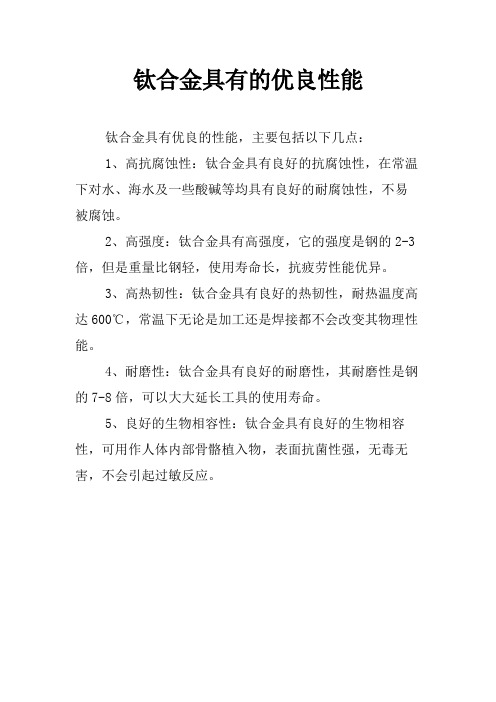
钛合金具有的优良性能
钛合金具有优良的性能,主要包括以下几点:
1、高抗腐蚀性:钛合金具有良好的抗腐蚀性,在常温下对水、海水及一些酸碱等均具有良好的耐腐蚀性,不易被腐蚀。
2、高强度:钛合金具有高强度,它的强度是钢的2-3倍,但是重量比钢轻,使用寿命长,抗疲劳性能优异。
3、高热韧性:钛合金具有良好的热韧性,耐热温度高达600℃,常温下无论是加工还是焊接都不会改变其物理性能。
4、耐磨性:钛合金具有良好的耐磨性,其耐磨性是钢的7-8倍,可以大大延长工具的使用寿命。
5、良好的生物相容性:钛合金具有良好的生物相容性,可用作人体内部骨骼植入物,表面抗菌性强,无毒无害,不会引起过敏反应。
tc4钛合金工作温度

tc4钛合金工作温度
【原创实用版】
目录
1.TC4 钛合金的概述
2.TC4 钛合金的性能特点
3.TC4 钛合金的工作温度范围
4.TC4 钛合金的应用领域
5.结论
正文
TC4 钛合金是一种优秀的金属材料,它具有许多优良的特性,如耐蚀性、小的密度、高的比强度及较好的韧性和焊接性等。
这些特性使 TC4 钛合金在航空航天、石油化工、造船、汽车,医药等部门都得到了广泛的应用。
TC4 钛合金的力学性能也是非常出色的,其抗拉强度达到 895 b/mpa,规定残余伸长应力为825 r0.2/mpa,伸长率为 10%,断面收缩率为 25%。
这种合金的密度为 4.5(g/cm3),工作温度范围为 -100~550℃。
在加工过程中,TC4 钛合金通常采用水淬或空冷的方式进行热处理淬火,其温度相变点以上为 30--·50。
这种处理方式可以有效地提高合金
的硬度和强度,提高其使用寿命。
总的来说,TC4 钛合金以其独特的性能和优良的加工特性,在许多领域都得到了广泛的应用。
第1页共1页。
钛合金具有的优良性能
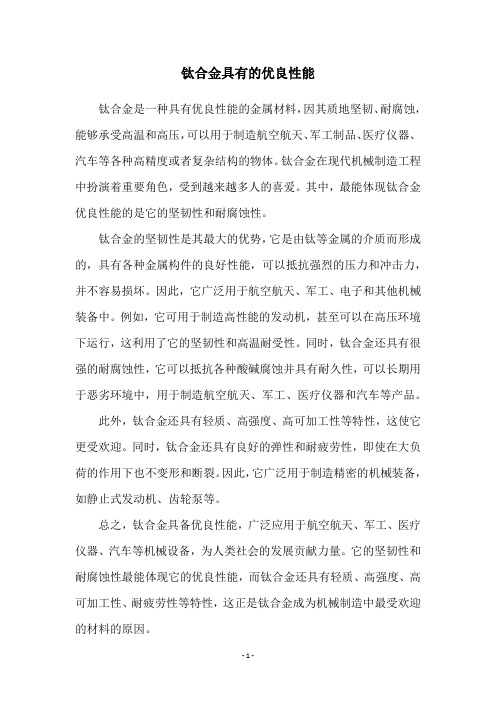
钛合金具有的优良性能
钛合金是一种具有优良性能的金属材料,因其质地坚韧、耐腐蚀,能够承受高温和高压,可以用于制造航空航天、军工制品、医疗仪器、汽车等各种高精度或者复杂结构的物体。
钛合金在现代机械制造工程中扮演着重要角色,受到越来越多人的喜爱。
其中,最能体现钛合金优良性能的是它的坚韧性和耐腐蚀性。
钛合金的坚韧性是其最大的优势,它是由钛等金属的介质而形成的,具有各种金属构件的良好性能,可以抵抗强烈的压力和冲击力,并不容易损坏。
因此,它广泛用于航空航天、军工、电子和其他机械装备中。
例如,它可用于制造高性能的发动机,甚至可以在高压环境下运行,这利用了它的坚韧性和高温耐受性。
同时,钛合金还具有很强的耐腐蚀性,它可以抵抗各种酸碱腐蚀并具有耐久性,可以长期用于恶劣环境中,用于制造航空航天、军工、医疗仪器和汽车等产品。
此外,钛合金还具有轻质、高强度、高可加工性等特性,这使它更受欢迎。
同时,钛合金还具有良好的弹性和耐疲劳性,即使在大负荷的作用下也不变形和断裂。
因此,它广泛用于制造精密的机械装备,如静止式发动机、齿轮泵等。
总之,钛合金具备优良性能,广泛应用于航空航天、军工、医疗仪器、汽车等机械设备,为人类社会的发展贡献力量。
它的坚韧性和耐腐蚀性最能体现它的优良性能,而钛合金还具有轻质、高强度、高可加工性、耐疲劳性等特性,这正是钛合金成为机械制造中最受欢迎的材料的原因。
tc4钛合金材料参数
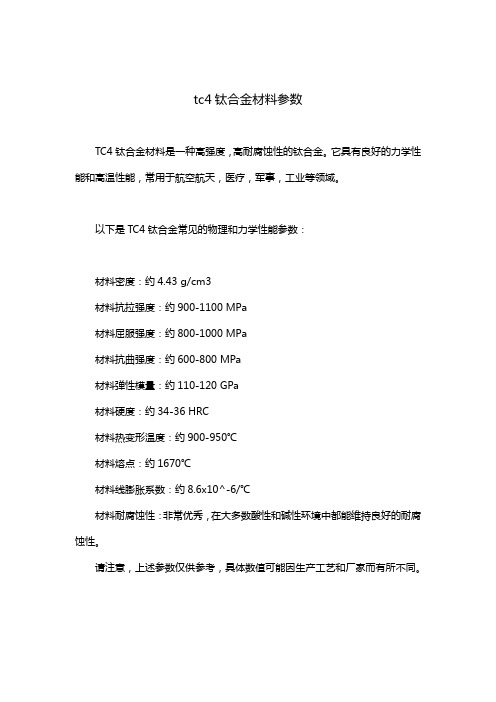
tc4钛合金材料参数
TC4钛合金材料是一种高强度,高耐腐蚀性的钛合金。
它具有良好的力学性能和高温性能,常用于航空航天,医疗,军事,工业等领域。
以下是TC4钛合金常见的物理和力学性能参数:
材料密度:约4.43 g/cm3
材料抗拉强度:约900-1100 MPa
材料屈服强度:约800-1000 MPa
材料抗曲强度:约600-800 MPa
材料弹性模量:约110-120 GPa
材料硬度:约34-36 HRC
材料热变形温度:约900-950℃
材料熔点:约1670℃
材料线膨胀系数:约8.6x10^-6/℃
材料耐腐蚀性:非常优秀,在大多数酸性和碱性环境中都能维持良好的耐腐蚀性。
请注意,上述参数仅供参考,具体数值可能因生产工艺和厂家而有所不同。
高强度钛合金型号及用途
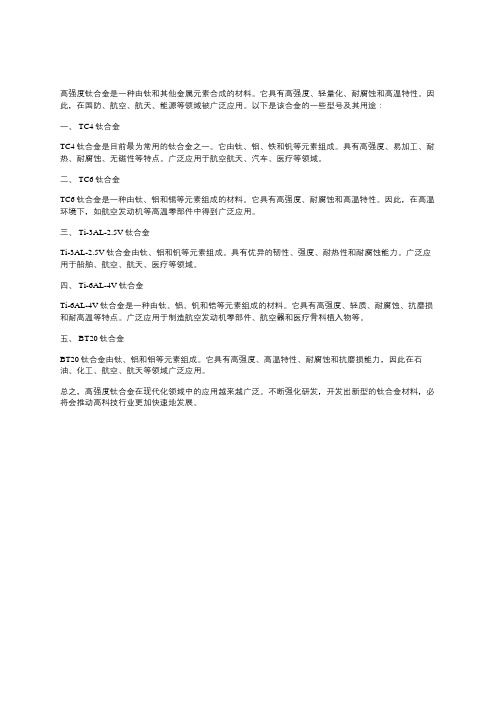
高强度钛合金是一种由钛和其他金属元素合成的材料。
它具有高强度、轻量化、耐腐蚀和高温特性。
因此,在国防、航空、航天、能源等领域被广泛应用。
以下是该合金的一些型号及其用途:
一、 TC4钛合金
TC4钛合金是目前最为常用的钛合金之一。
它由钛、铝、铁和钒等元素组成。
具有高强度、易加工、耐热、耐腐蚀、无磁性等特点。
广泛应用于航空航天、汽车、医疗等领域。
二、 TC6钛合金
TC6钛合金是一种由钛、铝和锡等元素组成的材料。
它具有高强度、耐腐蚀和高温特性。
因此,在高温环境下,如航空发动机等高温零部件中得到广泛应用。
三、 Ti-3AL-2.5V钛合金
Ti-3AL-2.5V钛合金由钛、铝和钒等元素组成。
具有优异的韧性、强度、耐热性和耐腐蚀能力。
广泛应用于船舶、航空、航天、医疗等领域。
四、 Ti-6AL-4V钛合金
Ti-6AL-4V钛合金是一种由钛、铝、钒和锆等元素组成的材料。
它具有高强度、轻质、耐腐蚀、抗磨损和耐高温等特点。
广泛应用于制造航空发动机零部件、航空器和医疗骨科植入物等。
五、 BT20钛合金
BT20钛合金由钛、铝和钼等元素组成。
它具有高强度、高温特性、耐腐蚀和抗磨损能力,因此在石油、化工、航空、航天等领域广泛应用。
总之,高强度钛合金在现代化领域中的应用越来越广泛。
不断强化研发,开发出新型的钛合金材料,必将会推动高科技行业更加快速地发展。
TC4钛合金成分及性能
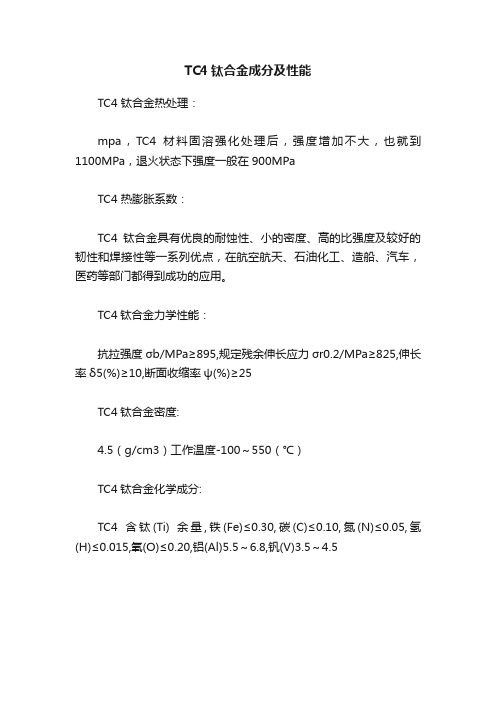
抗拉强度σb/MPa≥895,规定残余伸长应力σr0.2/MPa≥825,伸长率δ5(%)≥104.5(g/cm3)工作温度-100~550(℃)
TC4钛合金化学成分:
TC4含钛(Ti) 余量,铁(Fe)≤0.30,碳(C)≤0.10,氮(N)≤0.05,氢(H)≤0.015,氧(O)≤0.20,铝(Al)5.5~6.8,钒(V)3.5~4.5
tc4钛合金具有优良的耐蚀性小的密度高的比强度及较好的韧性和焊接性等一系列优点在航空航天石油化工造船汽车医药等部门都得到成功的应用
TC4钛合金成分及性能
TC4 钛合金热处理:
mpa,TC4材料固溶强化处理后,强度增加不大,也就到1100MPa,退火状态下强度一般在900MPa
TC4 热膨胀系数:
TC4钛合金具有优良的耐蚀性、小的密度、高的比强度及较好的韧性和焊接性等一系列优点,在航空航天、石油化工、造船、汽车,医药等部门都得到成功的应用。
tc4钛合金强度和钢强度
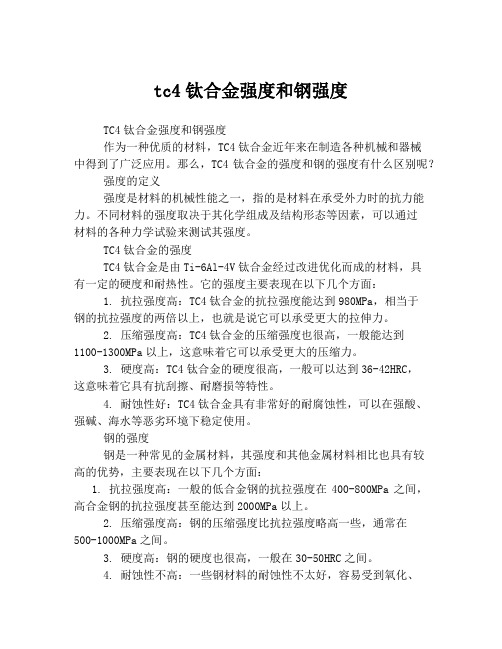
tc4钛合金强度和钢强度TC4钛合金强度和钢强度作为一种优质的材料,TC4钛合金近年来在制造各种机械和器械中得到了广泛应用。
那么,TC4钛合金的强度和钢的强度有什么区别呢?强度的定义强度是材料的机械性能之一,指的是材料在承受外力时的抗力能力。
不同材料的强度取决于其化学组成及结构形态等因素,可以通过材料的各种力学试验来测试其强度。
TC4钛合金的强度TC4钛合金是由Ti-6Al-4V钛合金经过改进优化而成的材料,具有一定的硬度和耐热性。
它的强度主要表现在以下几个方面:1. 抗拉强度高:TC4钛合金的抗拉强度能达到980MPa,相当于钢的抗拉强度的两倍以上,也就是说它可以承受更大的拉伸力。
2. 压缩强度高:TC4钛合金的压缩强度也很高,一般能达到1100-1300MPa以上,这意味着它可以承受更大的压缩力。
3. 硬度高:TC4钛合金的硬度很高,一般可以达到36-42HRC,这意味着它具有抗刮擦、耐磨损等特性。
4. 耐蚀性好:TC4钛合金具有非常好的耐腐蚀性,可以在强酸、强碱、海水等恶劣环境下稳定使用。
钢的强度钢是一种常见的金属材料,其强度和其他金属材料相比也具有较高的优势,主要表现在以下几个方面:1. 抗拉强度高:一般的低合金钢的抗拉强度在400-800MPa之间,高合金钢的抗拉强度甚至能达到2000MPa以上。
2. 压缩强度高:钢的压缩强度比抗拉强度略高一些,通常在500-1000MPa之间。
3. 硬度高:钢的硬度也很高,一般在30-50HRC之间。
4. 耐蚀性不高:一些钢材料的耐蚀性不太好,容易受到氧化、腐蚀等影响。
TC4钛合金和钢的强度比较从以上的比较可以看出,TC4钛合金和钢都具有很高的强度,但在抗拉强度和耐蚀性方面,TC4钛合金的表现要比钢更优秀,而在压缩强度和硬度方面,钢材料相对更优秀一些。
因此,在不同的工程中可以根据需要分别选用这两种材料。
总结TC4钛合金是一种非常优秀的材料,其强度和钢材料相比有一些不同之处,但两者都具有很高的机械性能。
钛合金常用规格及性能用途

钛合金经常使用规格及性能用途之宇文皓月创作TC4 / GR5 / Ti6AL4V 钛棒现货规格:直径2mm 2.5mm 3.0mm 3.5mm 4.0mm 5.0mm 6.0mm 7.0mm 8mm 9mm 10mm直径12mm 15mm 16mm 18mm20mm 25mm 30mm 35mm 40mm 45mm 50mm 55mm直径60mm 65mm 70mm 75mm 80mm 85mm 90mm 100mm 105mm 110mm 120mm TC4 / GR5 / Ti6AL4V 钛棒现货规格:厚度1mm 1.5mm 2mm 2.5mm 3mm 4mm 4.5mm 5mm 6mm 7mm 8mm 10mm 12mm14mm厚度16mm 18mm 20mm 25mm 30mm 32mm 35mm 50mm 45mm 50mm 60mm 70mm 80mm 90mm钛合金优越的特性:1耐酸碱腐蚀,耐海水腐蚀,耐污水腐蚀;2密度小(4.51),轻;3无磁性;广钛金属4在-253°-600°之间使用,他的抗拉强度,在金属中,几乎是最高的。
应用举例:工业上除采取工业纯钛制造零件以外,大量使用的是钛合金。
它在航空、航天、化工、造船、冶金、电子、医疗、石油、医药、军工等工业部分获得日益广泛的应用,制造燃气轮机部件。
【钛合金的性能】钛是一种新型金属,钛的性能与所含碳、氮、氢、氧等杂质含量有关,最纯的碘化钛杂质含量不超出0.1%,但其强度低、塑性高。
99.5%工业纯钛的性能为:密度ρ=4.5g/cm3,熔点为172矽钛合金耐磨地坪5℃,导热系数λ=15.24W/(m.K),抗拉强度σb=539MPa,伸长率δ=25%,断面收缩率ψ=25%,弹性模量E=1.078×105MPa,硬度HB195。
(1)强度高钛合金的密度一般在4.5g/cm3左右,仅为钢的60%,纯钛的强度才接近普通钢的强度,一些高强度钛合金超出了许多合金结构钢的强度。
钛合金tc4

03
钛合金TC4的应用领域
航空航天领域的应 用
• 钛合金TC4在航空航天领域的应用 • 制造发动机压气机盘、涡轮叶片等关键部件 • 制造飞机结构件、起落架等部件 • 制造航天器零部件、火箭发动机喷嘴等部件
汽车制造领域的应 用
• 钛合金TC4在汽车制造领域的应用 • 制造发动机气门、曲轴等关键部件 • 制造变速器齿轮、轴承等部件 • 制造车身结构件、底盘件等部件
钛合金TC4的物理性能
01 钛合金TC4的密度
• 密度:g/cm³ • 熔点:1668℃
02 钛合金TC4的热导率
• 热导率:20W/(m·K) • 热膨胀系数:×10⁻⁶/℃
03 钛合金TC4的电导率
• 电导率:×10⁻⁸S/m • 磁导率:×10⁻⁶H/m
02
钛合金TC4的制备工艺
钛合金TC4的熔炼与铸造工艺
医疗领域的应用
• 钛合金TC4在医疗领域的应用 • 制造人工关节、牙科种植体等医疗器械 • 制造心脏起搏器、人工心脏瓣膜等心血管医疗器械 • 制造外科手术器械、内窥镜等医疗设备
04
钛合金TC4的发展趋势与挑战
钛合金TC4的研究进展
• 钛合金TC4的研究进展 • 提高材料利用率、生产效率 • 开发新型加工工艺、新型组织结构 • 研究表面改性技术、性能优化
钛合金TC4的力学性能
钛合金TC4的室温力学性能
• 密度:g/cm³ • 熔点:1668℃ • 屈服强度:960MPa • 抗拉强度:980MPa • 延伸率:6%
钛合金TC4的高温力学性能
• 800℃时的屈服强度:800MPa • 800℃时的抗拉强度:850MPa • 800℃时的延伸率:6%
钛合金TC4的熔炼工艺
[新版]钛合金常用规格及性能用途
![[新版]钛合金常用规格及性能用途](https://img.taocdn.com/s3/m/3be23c59ff4733687e21af45b307e87100f6f845.png)
钛合金常用规格及性能用途0000000000000TC4 / GR5 / Ti6AL4V 钛棒现货规格:0000000000000直径2mm 2.5mm 3.0mm 3.5mm 4.0mm 5.0mm 6.0mm 7.0mm 8mm 9mm 10mm 000000000000直径12mm 15mm 16mm 18mm 20mm 25mm 30mm 35mm 40mm 45mm 50mm 55mm 000000000000直径60mm 65mm 70mm 75mm 80mm 85mm 90mm 100mm 105mm 110mm 120mm 000000000000TC4 / GR5 / Ti6AL4V 钛棒现货规格:0000000000000厚度1mm 1.5mm 2mm 2.5mm 3mm 4mm 4.5mm 5mm 6mm 7mm 8mm 10mm 12mm 14mm 000000000000厚度16mm 18mm 20mm 25mm 30mm 32mm 35mm 50mm 45mm 50mm 60mm 70mm 80mm 90mm 0000000000000钛合金优越的特性:00000000000001耐酸碱腐蚀,耐海水腐蚀,耐污水腐蚀;00000000000002密度小(4.51),轻;00000000000003无磁性;广钛金属00000000000004在-253°-600°之间使用,他的抗拉强度,在金属中,几乎是最高的。
000000000000应用举例:工业上除采用工业纯钛制造零件以外,大量使用的是钛合金。
它在航空、航天、化工、造船、冶金、电子、医疗、石油、医药、军工等工业部门获得日益广泛的应用,制造燃气轮机部件。
0000000000000【钛合金的性能】0000000000000钛是一种新型金属,钛的性能与所含碳、氮、氢、氧等杂质含量有关,最纯的碘化钛杂质含量不超过0.1%,但其强度低、塑性高。
钛合金的优良性能
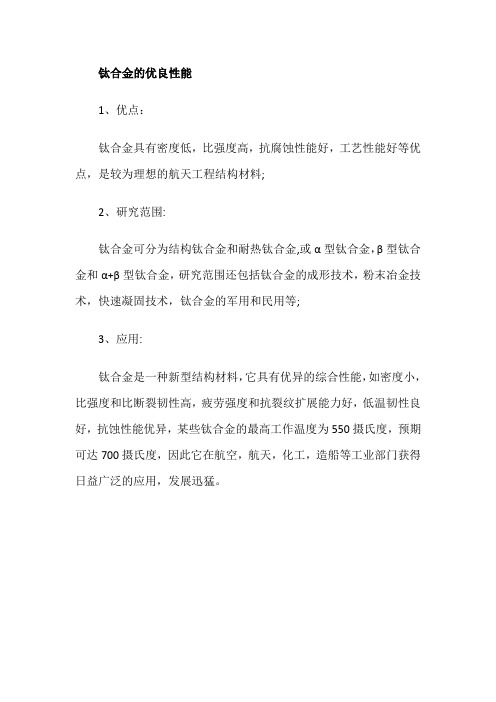
钛合金的优良性能
1、优点:
钛合金具有密度低,比强度高,抗腐蚀性能好,工艺性能好等优点,是较为理想的航天工程结构材料;
2、研究范围:
钛合金可分为结构钛合金和耐热钛合金,或α型钛合金,β型钛合金和α+β型钛合金,研究范围还包括钛合金的成形技术,粉末冶金技术,快速凝固技术,钛合金的军用和民用等;
3、应用:
钛合金是一种新型结构材料,它具有优异的综合性能,如密度小,比强度和比断裂韧性高,疲劳强度和抗裂纹扩展能力好,低温韧性良好,抗蚀性能优异,某些钛合金的最高工作温度为550摄氏度,预期可达700摄氏度,因此它在航空,航天,化工,造船等工业部门获得日益广泛的应用,发展迅猛。
钛合金常用规格及性能用途
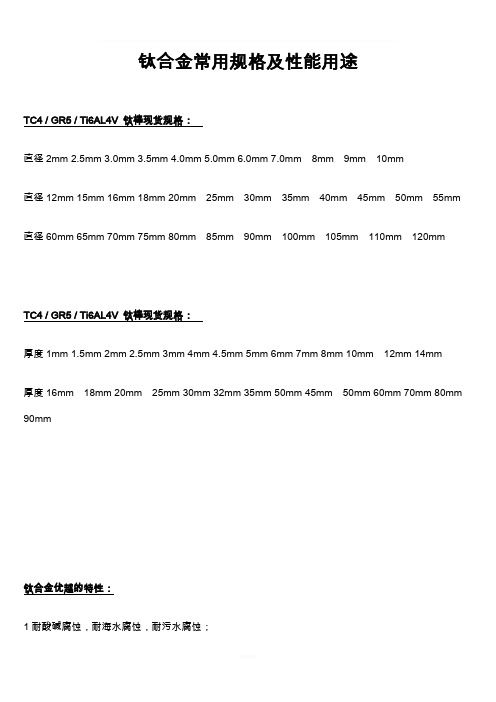
钛合金常用规格及性能用途TC4 / GR5 / Ti6AL4V 钛棒现货规格:直径2mm 2.5mm 3.0mm 3.5mm 4.0mm 5.0mm 6.0mm 7.0mm8mm9mm10mm直径12mm 15mm 16mm 18mm 20mm25mm30mm35mm40mm45mm50mm55mm 直径60mm 65mm 70mm 75mm 80mm85mm90mm100mm105mm110mm120mmTC4 / GR5 / Ti6AL4V 钛棒现货规格:厚度1mm 1.5mm 2mm 2.5mm 3mm 4mm 4.5mm 5mm 6mm 7mm 8mm 10mm12mm 14mm厚度16mm18mm 20mm25mm 30mm 32mm 35mm 50mm 45mm50mm 60mm 70mm 80mm 90mm钛合金优越的特性:1耐酸碱腐蚀,耐海水腐蚀,耐污水腐蚀;2密度小(4.51),轻;3无磁性;广钛金属4在-253°-600°之间使用,他的抗拉强度,在金属中,几乎是最高的。
应用举例:工业上除采用工业纯钛制造零件以外,大量使用的是钛合金。
它在航空、航天、化工、造船、冶金、电子、医疗、石油、医药、军工等工业部门获得日益广泛的应用,制造燃气轮机部件。
【钛合金的性能】钛是一种新型金属,钛的性能与所含碳、氮、氢、氧等杂质含量有关,最纯的碘化钛杂质含量不超过0.1%,但其强度低、塑性高。
99.5%工业纯钛的性能为:密度ρ=4.5g/cm3,熔点为172矽钛合金耐磨地坪5℃,导热系数λ=15.24W/(m.K),抗拉强度σb=539MPa,伸长率δ=25%,断面收缩率ψ=25%,弹性模量E=1.078×105MPa,硬度HB195。
(1)强度高钛合金的密度一般在4.5g/cm3左右,仅为钢的60%,纯钛的强度才接近普通钢的强度,一些高强度钛合金超过了许多合金结构钢的强度。
钛合金含量
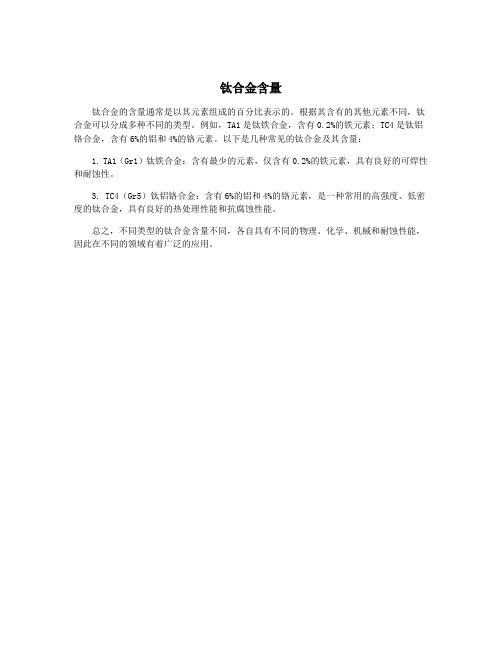
钛合金含量
钛合金的含量通常是以其元素组成的百分比表示的。
根据其含有的其他元素不同,钛合金可以分成多种不同的类型。
例如,TA1是钛铁合金,含有0.2%的铁元素;TC4是钛铝铬合金,含有6%的铝和4%的铬元素。
以下是几种常见的钛合金及其含量:
1. TA1(Gr1)钛铁合金:含有最少的元素,仅含有0.2%的铁元素,具有良好的可焊性和耐蚀性。
3. TC4(Gr5)钛铝铬合金:含有6%的铝和4%的铬元素,是一种常用的高强度、低密度的钛合金,具有良好的热处理性能和抗腐蚀性能。
总之,不同类型的钛合金含量不同,各自具有不同的物理、化学、机械和耐蚀性能,因此在不同的领域有着广泛的应用。
tc4钛合金工作温度
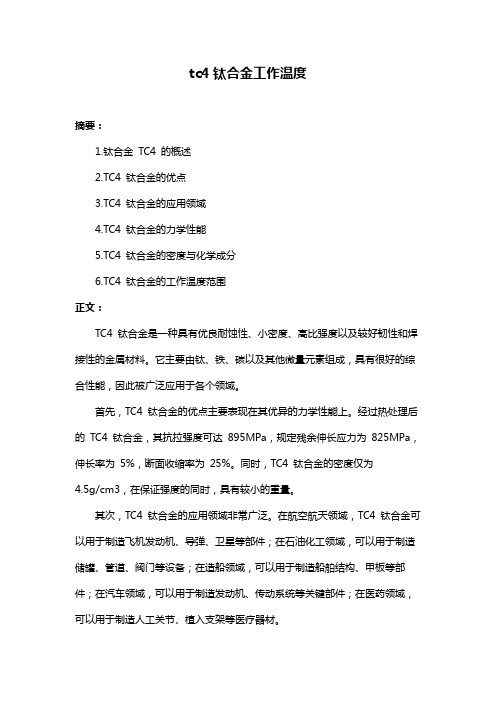
tc4钛合金工作温度
摘要:
1.钛合金TC4 的概述
2.TC4 钛合金的优点
3.TC4 钛合金的应用领域
4.TC4 钛合金的力学性能
5.TC4 钛合金的密度与化学成分
6.TC4 钛合金的工作温度范围
正文:
TC4 钛合金是一种具有优良耐蚀性、小密度、高比强度以及较好韧性和焊接性的金属材料。
它主要由钛、铁、碳以及其他微量元素组成,具有很好的综合性能,因此被广泛应用于各个领域。
首先,TC4 钛合金的优点主要表现在其优异的力学性能上。
经过热处理后的TC4 钛合金,其抗拉强度可达895MPa,规定残余伸长应力为825MPa,伸长率为5%,断面收缩率为25%。
同时,TC4 钛合金的密度仅为
4.5g/cm3,在保证强度的同时,具有较小的重量。
其次,TC4 钛合金的应用领域非常广泛。
在航空航天领域,TC4 钛合金可以用于制造飞机发动机、导弹、卫星等部件;在石油化工领域,可以用于制造储罐、管道、阀门等设备;在造船领域,可以用于制造船舶结构、甲板等部件;在汽车领域,可以用于制造发动机、传动系统等关键部件;在医药领域,可以用于制造人工关节、植入支架等医疗器材。
此外,TC4 钛合金的密度和化学成分也是其性能的重要指标。
TC4 钛合金的密度为4.5g/cm3,化学成分主要包括钛、铁、碳以及其他微量元素。
这些成分的合理搭配使得TC4 钛合金具有了优良的性能。
最后,TC4 钛合金的工作温度范围为-100℃至550℃。
在这个温度范围内,TC4 钛合金可以保持良好的性能,因此在各种恶劣环境下都能发挥稳定的作用。
- 1、下载文档前请自行甄别文档内容的完整性,平台不提供额外的编辑、内容补充、找答案等附加服务。
- 2、"仅部分预览"的文档,不可在线预览部分如存在完整性等问题,可反馈申请退款(可完整预览的文档不适用该条件!)。
- 3、如文档侵犯您的权益,请联系客服反馈,我们会尽快为您处理(人工客服工作时间:9:00-18:30)。
This property of titanium shows that its yield ratio (tensile strength / yield strength) is soaring, indicating that the metallic titanium material has poor plastic deformation upon forming. Due to the titanium yield strength and elastic modulus of the ratio of fat, the resilience of titanium molding large.
Titanium is a chemically very reactive metal that reacts with many elements and compounds at elevated temperatures. Titanium suction mainly refers to elevated temperature and carbon, hydrogen, nitrogen, oxygen reaction.
6, non-magnetic, non-toxic
Titanium is non-magnetic metal that cannot be magnetized in a large magnetic field. It is non-toxic and has excellent compatibility with human tissues and blood. Therefore, titanium is employed in the medical field.
GR5 Titanium top ten properties
1, low density, high strength
Titanium metal density of 4.51g / cubic centimetres, higher than the aluminum and lower than steel, copper, nickel, but the intensity in the first metal.
9, low modulus of elasticity
The modulus of elasticity of titanium is 106.4 GPa at room temperature, which is 57% of the steel.
10, inspiratory performance
3, good heat resistance
The new titanium alloy can be long-term use at 600 or higher temperature.
4, low-temperature performance is good
Titanium alloy TA7 (Ti-5Al-2.5Sn), TC4 (Ti-6Al-4V) and Ti-2.5Zr-1.5Mo and other low temperature titanium alloy represented by its strength decreases with decreasing temperature, but the plasticity is not Big. In the -196-253 low temperature to maintain good ductility and toughness, to avoid the metal cold brittleness, low temperature containers, tanks and other equipment ideal material.
8, good heat transfer performance
Although the thermal conductivity of titanium metal than carbon steel and copper is low, but because of titanium excellent corrosion resistance, so the wall thickness can be greatly reduced, and the surface and steam heat transfer mode drops condensate, reducing the heat group, too the surface Not scaling can also reduce the thermal resistance, so that the heat transfer performance of titanium significantly improved.
GR5,TC4钛合金十大性能
GR5钛合金又名TC4钛合金,也叫它6Al4V,这是用途最广的一种钛金属,通常我们使用的钛合金就指它。它拥有良好的前度和延伸率。
GR5,TC4钛合金的十大性能
1、密度小,比强度高
金属钛的密度为4.51g/立方厘米,高于铝而低于钢、铜、镍,但比强度位于金属之首。
In order to improve the corrosion resistance of titanium, surface treatment technologies such as oxidation, electroplating, plasma spraying, ion nitriding, ion implantation and laser treatment have been developed to enhance the protective effect of the titanium oxide film and obtain the desired corrosion resistance effect. In response to the need for metal materials in the production of sulfuric acid, hydrochloric acid, methylamine solution, high temperature wet chlorine and high temperature chloride, a series of corrosion resistant titanium alloys such as titanium molybdenum, titanium-palladium, titanium-molybdenum-nickel have been developed. Titanium-32 molybdenum alloy is used for titanium casting, and titanium-0.2 molybdenum-0.8 nickel alloy or titanium equipment is used for titanium-0.2 palladium alloy for the environment where crevice corrosion or pitting corrosion often occurs, and both are well utilized effect.
3、耐热性能好
新型钛合金可在600℃或更高的温度下长期使用。
4、耐低温性能好
钛合金TA7(Ti-5Al-2.5Sn),TC4(Ti-6Al-4V)和Ti-2.5Zr-1.5Mo等为代表的低温钛合金,其强度随温度的降低而提高,但塑性变化却不大。在-196-253℃低温下保持较好的延性及韧性,避免了金属冷脆性,是低温容器,贮箱等设备的理想材料。
5、抗阻尼性能强
金属钛受到机械振动、电振动后,与钢、铜金属相比,其自身振动衰减时间最长。利用钛的这一性能可作音叉、医学上的超声粉碎机振动元件和高级音响扬声器的振动薄膜等。
6、无磁性、无毒
钛是无磁性金属,在很大的磁场中也不会被磁化,无毒且与人体组织及血液有好的相溶性,所以被医疗界采用。
7、抗拉强度与其屈服强度接近
钛的这一性能说明了其屈强比(抗拉强度/屈服强度)高,表示了金属钛材料在成形时塑性变形差。由于钛的屈服极限与弹性模量的比值大,使钛成型时的回弹能力大。
8、换热性能好
金属钛的导热系数虽然比碳钢和铜低,但由于钛优异的耐腐蚀性能,所以壁厚可以大大减薄,而且表面与蒸汽的换热方式为滴状冷能显著提高。
2, corrosion resistance
Titanium is a very lively metal with a very low equilibrium potential and a high tendency for thermodynamic corrosion in the medium. However, titanium is actually very stable in many media, such as titanium, which is resistant to corrosion in media such as oxidizing, neutral and weakly reducing.
5, anti-damping performance
Titanium metal by mechanical vibration, electrical vibration, compared with steel, copper metal, the longest vibration decay time. The use of titanium for this performance can be invoked as a tuning fork, medical ultrasonic vibration elements and advanced audio speakers vibrating membrane.
